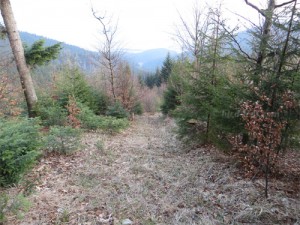 Finding Hazel Grouse is equivalent of knowing the habits of the Hazel Grouse which means also knowing and recognizing the habitat of the Hazel Grouse. The search for the right habitat is not eased by the fact, that the Hazel Grouse has at least 3 different habitat requirements during the year in the different seasons. In general the Grouse prefers the following habitat structures. Young forest stages with pioneer forest character. A high percentage of soft wood species like Birch (Betula pendula) and Hazel (Corylus avelana) Willow (Salix sp.) is important. Herbs and shrubs with should be abundant but not too dense. Berry bushes are highly thought-after by the Hazel Grouse. Nearby there should be deep conifer thickets. Important is, that the branches almost reach to the ground. This habitat requirement is especially important as cover and winter habitat. Open micro habitats of relatively low ground vegetation (glades, trails, timber roads, forest edges, old timber stock in decaying phase). The Hazel Grouse pronounce remarkable seasonal changes in habitat selection, due to changes in the food and the coverage range . The following forest structures were used as habitat:
Finding Hazel Grouse is equivalent of knowing the habits of the Hazel Grouse which means also knowing and recognizing the habitat of the Hazel Grouse. The search for the right habitat is not eased by the fact, that the Hazel Grouse has at least 3 different habitat requirements during the year in the different seasons. In general the Grouse prefers the following habitat structures. Young forest stages with pioneer forest character. A high percentage of soft wood species like Birch (Betula pendula) and Hazel (Corylus avelana) Willow (Salix sp.) is important. Herbs and shrubs with should be abundant but not too dense. Berry bushes are highly thought-after by the Hazel Grouse. Nearby there should be deep conifer thickets. Important is, that the branches almost reach to the ground. This habitat requirement is especially important as cover and winter habitat. Open micro habitats of relatively low ground vegetation (glades, trails, timber roads, forest edges, old timber stock in decaying phase). The Hazel Grouse pronounce remarkable seasonal changes in habitat selection, due to changes in the food and the coverage range . The following forest structures were used as habitat:
– Early Summer: younger wood species of deciduous forest with gaps and well-developed herb and shrub layer. Dominant wood species were Birch (Betula pendula) and Hazel (Corylus avelana) and thickets of Beech (Fagus sylvatica), Ash (Fraxinus excelsior) and Sycamore (Acer pseudoplatanus)
– Late Summer, Fall: gappy areas with Spruce (Picea abies) with berry-bearing shrubs, small wetland sites like springs with fresh ground vegetation
– Winter: dense conifer stocks with a minimum percentage blend of Birch, Red Alder (Alnus glutinosa) and Hazel
– Spring: Border areas of deciduous trees to coniferous stands.
All year round richly textured areas along forest paths were used. It is along the forest roads where dust bathing sites of the Hazel Grouse is found.
It should be noticed, that literature mentions different habitat preferences for different subspecies of the Hazel Grouse. In the consequence the habitat descriptions mentioned above showed to fit quite well with the habitats the photographed Hazel Grouses lived in.
But first, you must yourself fit in the environment of the Hazel Grouse. The best is, to use a hide……………